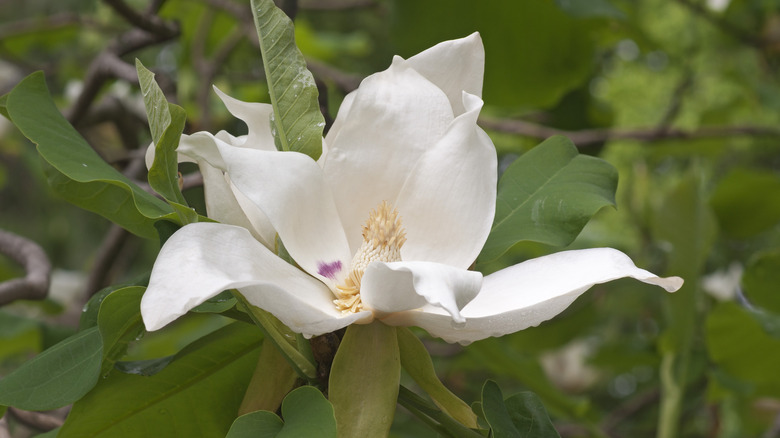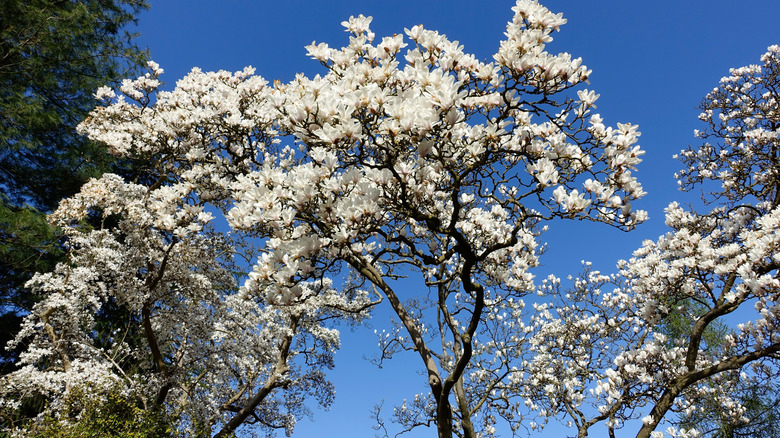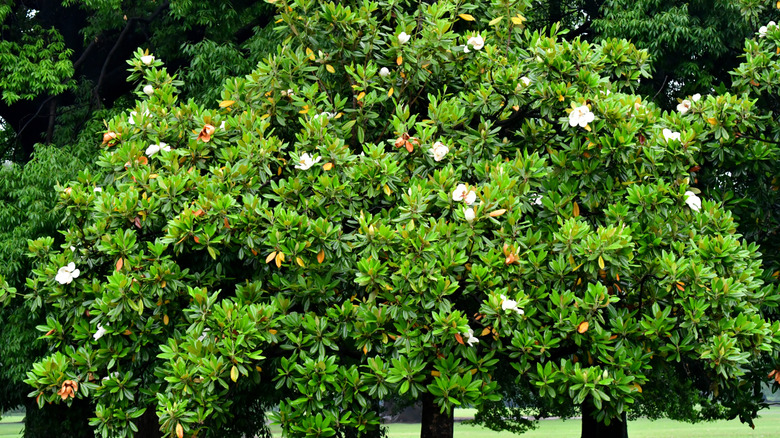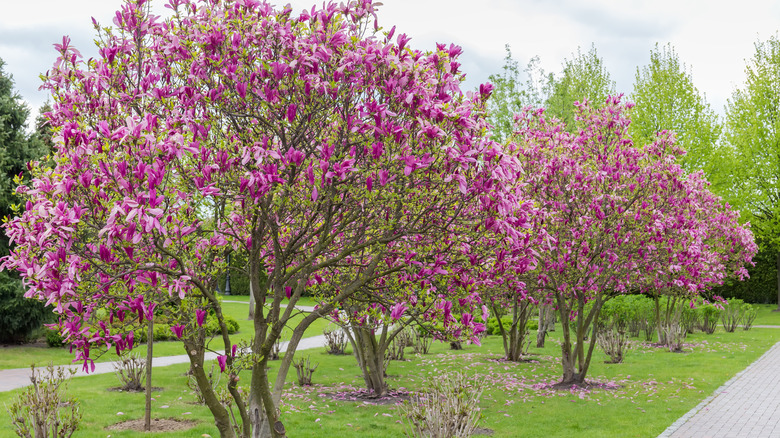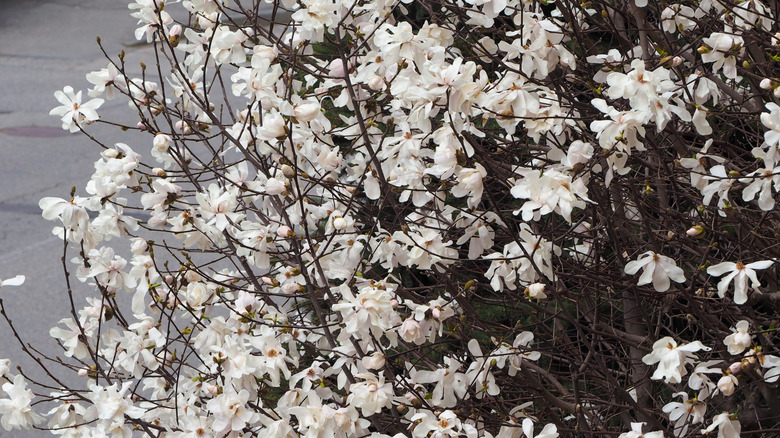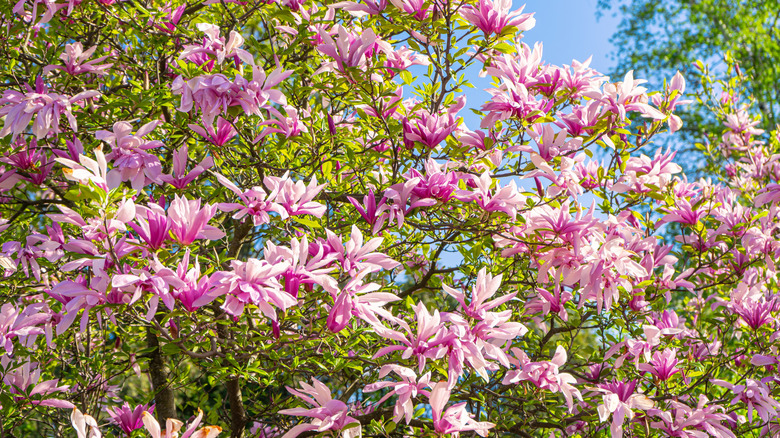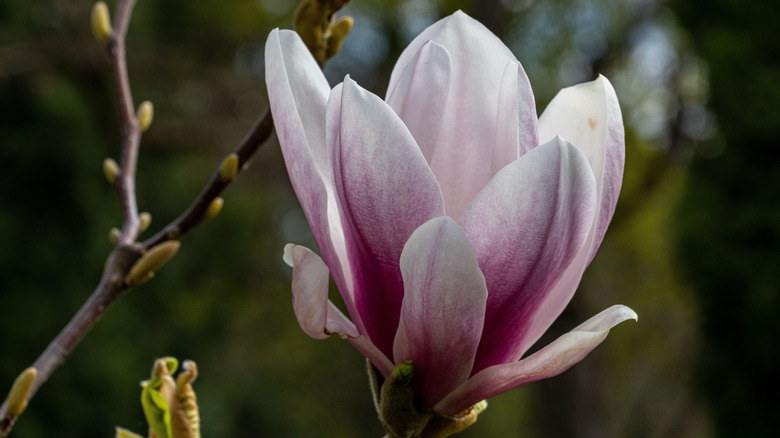17 Varieties Of Magnolias You Can Grow In Your Yard Or Garden
Have you ever dreamed of having a backyard or garden filled with the sweet, perfumy scent of fresh magnolia blossoms in the spring? If so, you'll be happy to know there is a wide range of varieties to choose from that can make that dream a reality in almost any hardiness zone. When preparing to grow and care for magnolia trees, you will want to consider the best growing environment for the variety you choose. Each species has special considerations, including the climate, soil, sunlight, and space.
Understanding the specific requirements that your magnolia tree needs will help ensure your magnolia flower buds bloom year after year. Smaller varieties like Ashe, banana, and star magnolias generally need about 24 feet of space to grow. Larger varieties like Jade Lily trees or Southern magnolias may need up to 60 feet of space to grow. Most magnolia varieties grow best in full sun, but some can also do well in partial shade. They also usually prefer moist, well-draining soil, but acidity differs depending on the variety. Whatever space and conditions you have available, here are 17 varieties of magnolias you may be able to grow in your yard or garden.
Ashe magnolia
For smaller spaces that can't support a full-grown tree, the Ashe magnolia tree (Magnolia ashei) can bring the beauty of magnolias into your yard. This large perennial shrub grows in USDA hardiness zones 6 to 9. It needs 8 to 10 feet of space to grow in full sun or partial shade, and it can get up to 15 feet tall. The Ashe Magnolia features large green leaves and white, cup-shaped flowers with 6 petals that bloom in the spring and summer. They bloom later in the spring than most magnolia varieties, so they are less likely to lose blooms to frost.
Jade lily magnolia
Jade lily trees (Magnolia denudata) are much larger than Ashe magnolias, growing up to 40 feet wide and 40 feet high. It is commonly planted as an ornamental tree to attract pollinators in zones 6 to 8. If you are looking to plant it in your yard or garden, you will want to make sure to look for a spot with enough space that gets full or partial sun. The soils should be moist and well-draining, like loamy or sandy soil. In the spring and winter, you can expect to see cup-shaped flowers with six petals and oblong leaves.
Earleaf magnolia
If you are more interested in attracting birds with your magnolia tree, you could consider planting the earleaf magnolia tree (Magnolia fraseri). This is another larger variety that can grow up to 40 feet tall in zones 6 to 9. It does best when planted in acidic, well-draining soil in full or partial sun. The fragrant, wheel-shaped flowers can grow to be about 12 inches, and can be gold, white, or tan. Plus, the tree produces blue, orange, or pink fruit in the spring that attracts wildlife like small mammals and songbirds.
Banana magnolia
The banana magnolia (Magnolia figo) is a smaller magnolia variety that is generally considered a shrub that grows to be 6 to 10 feet wide and up to 20 feet high. It grows best with a space of at least 12 feet in zones 7 to 10. It is generally planted as a landscaping feature that is also deer-resistant. In the spring and summer, it will bloom with small, cup-shaped flowers with six petals that can be cream, yellow, green, or purple. For best results, plant in full sun or partial shade with acidic, well-draining soil.
Southern magnolia
For a stunning magnolia species you can plant for white flowers, you should definitely be considering the southern magnolia tree (Magnolia grandiflora). It is a large tree that grows in zones 6 to 10, reaching up to 50 feet wide and 80 feet tall. It is one of the most popular magnolia varieties because it offers a wide variety of garden benefits, such as attracting pollinators and wildlife, providing shade, and producing edible fruit. Gardeners also love the stunning glossy leaves and white saucer-shaped flowers that burst to life in the spring and summer.
Kobus magnolia
Kobus magnolia trees (Magnolia kobus) are originally from Korea or Japan. They can grow as perennials in zones 5 to 8, but they are considered invasive in some regions like New Jersey, so it is best to check with local authorities before planting. They can grow to be about 35 feet wide and up to 40 feet tall. Unlike other varieties that like acidic soil, kobus magnolias like alkaline, loamy soil. In the spring, they produce white, red, or pink flowers that reach up to 6 inches in diameter.
Lily magnolia
Another great option for small spaces that produces a mass of blooms is the lily magnolia (Magnolia liliiflora). It is considered a shrub or small tree that grows to be 8 to 12 feet tall in zones 5 to 8. In the spring, the branches fill with white or purple, fragrant flowers. The lily-shaped blooms can grow up to 6 inches with 7 to 20 petals per flower. Lily magnolia trees grow best in full or partial sun with acidic, well-draining soil.
Bigleaf magnolia
Bigleaf magnolia trees (Magnolia macrophylla) are native to the United States, growing in zones 5 to 8. They are a larger variety that can grow 40 feet wide and 40 feet tall. They grow best when they are given up to 60 feet of room to grow in full or partial sun with acidic, well-draining soil. Gardeners love these trees because they attract pollinators, hummingbirds, songbirds, and other beneficial wildlife to the garden. They also produce cup-shaped white or purple flowers in the spring with large green leaves.
Oyama magnolia
If you're looking for something that will start producing blooms quickly, the Oyama magnolia (Magnolia sieboldii) is a small variety that blooms earlier than most magnolia varieties. They grow in zones 6 to 8 and can be 15 feet wide and 20 feet tall when fully grown. Typically, they produce small cup-shaped flowers in the summer that can be white, pink, or yellow. Unlike other varieties of magnolias that like full sun, Oyama magnolias should be planted in partial shade.
Star magnolia
Star magnolias (Magnolia stellata) are known for being a stunning white flowering tree that will fill your yard with a heavenly scent. This slow-growing variety is considered a medium-sized tree that reaches up to 15 feet wide and 20 feet tall in zones 4 to 8. The strong fragrance and beautiful flowers that attract pollinators and songbirds make the star magnolia tree an attractive option for anyone looking to add a valuable landscaping feature to their yard or garden. It produces small, white, star-shaped flowers that can have 7 to 20 petals in the spring and winter.
Umbrella magnolia
Another full-sized tree that is native to the United States is the umbrella magnolia (Magnolia tripetala), which grows to be 30 feet wide and 40 feet tall in zones 5 to 8. It is generally planted for ornamental value, because of the large green leaves and showy flowers in the spring, but it can also attract pollinators and songbirds. However, the flowers produce a more unpleasant odor than most magnolias, so it isn't the best choice if you want fragrant flowers. The flowers are usually about 6 inches in diameter with white or cream petals.
Sweetbay magnolia
Another popular magnolia variety is the sweetbay magnolia tree (Magnolia virginiana), which brings butterflies and other benefits to your yard. This United States native tree is also considered a shrub that can grow between 10 to 35 feet in zones 5 to 10. It is known for producing small, pleasant-smelling white blooms that bloom in the spring and summer. The flowers are cup-shaped with 7 to 20 petals. In the fall, its fruit is a valuable food source for local wildlife.
Loebner magnolia
The Lobner magnolia tree (Magnolia x loebneri) is a hybrid of Kobus magnolia and the star magnolia trees. It is a small tree that grows to be 20 to 30 feet tall in zones 5 to 9. It is usually planted for ornamental purposes or for the fragrant flowers. It does best when planted in full sun or partial shade and acidic soil. In the spring and summer, it blooms with white flowers that have 7 to 20 petals.
Saucer magnolia
The saucer magnolia tree (Magnolia x soulangeana) is a pink and purple magnolia tree variety you'll want to plant for beautiful blooms. This smaller species can also be considered a large shrub that grows between 15 and 25 feet wide and up to 30 feet tall. They are hardy in zones 4 to 9 with blooms in the spring. The cup-sized flowers grow to be about 6 inches in diameter and can be white, pink, or purple. They are known for attracting caterpillars and bees, which provide benefits to your garden.
Zen magnolia
If you are trying to create a tranquil garden space, the zen magnolia tree (Magnolia zenii) may be the right choice. It is a smaller tree that can get up to 15 feet wide and 25 feet tall in zones 5 to 8. Native to China, it is commonly used in Asian-themed gardens in locations where it can get full sun. It can thrive in neutral or acidic soil. In late winter and spring, the zen magnolia has yellow, purple, or white cup-shaped blossoms.
Anise magnolia
The anise magnolia tree (Magnolia salicifolia) features small, delicate white flowers that bloom in the spring in zones 4 to 7. They are a larger variety that can grow to be up to 50 feet tall. You can plant them in clay, loamy, or sandy soil, as long as it is acidic. Plus, they can grow well in full or partial sun. The flowers are about 3 to 6 inches in diameter with six petals that attract butterflies and bees, which can help pollinate the rest of your garden.
Cucumber magnolia
Cucumber magnolia trees (Magnolia acuminata) are named for the cucumber-shaped fruit that they produce in the summer. However, it still has stunning, small greenish-yellow or gold bell-shaped flowers in the spring. The cucumber magnolia is native to the United States and is hardy in zones 4 to 8. While it generally prefers loamy soil, it is relatively versatile when it comes to planting conditions. It can thrive in neutral or acidic soil and both full and partial sun conditions.

